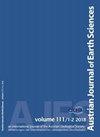估算含气页岩孔隙度、粘土体积和含水饱和度的岩石物理方法:以加拿大合恩河盆地为例
IF 1.1
4区 地球科学
Q2 Earth and Planetary Sciences
引用次数: 5
摘要
页岩气部分作为黏土矿物吸附的气体存在,部分作为孔隙中的游离气体存在。为了评估页岩气储层并计算总含气量,必须准确分析孔隙度、粘土体积和含水饱和度。在本研究中,我们使用各种类型的测井数据,如密度测井、声波测井、电阻率测井和中子孔隙度测井,对合恩河流域的这些因素进行了估计。由于简单的密度孔隙度方程会导致不合理的流体密度,因此我们使用总有机碳来估算孔隙度。基于脆性,定义了粘土体积的经验方程。由于岩心测试粘土体积与含水饱和度的相关系数大于0.9,因此含水饱和度的经验方程也可以用脆性来定义。对于合恩河盆地页岩气储层,孔隙度可采用密度对数线性方程计算,粘土体积和含水饱和度可采用杨氏模量和泊松比线性关系计算。研究表明,利用地震反演建立的弹性模型可以建立孔隙度、粘土体积和含水饱和度模型。本文章由计算机程序翻译,如有差异,请以英文原文为准。
Petrophysical approach for estimating porosity, clay volume, and water saturation in gas-bearing shale: A case study from the Horn River Basin, Canada
Shale gas exists partly as a gas adsorbed to clay mineral and partly as a free gas within the pores. To evaluate a shale gas reservoir and calculate total gas content, it is essential to accurately analyze porosity, clay volume, and water saturation. In this study, we estimate these factors for the Horn River Basin using various types of well log data such as density log, sonic log, resistivity log, and neutron porosity log. Because a simple density porosity equation results in unreasonable fluid densities, we estimate porosity using total organic carbon. Based on brittleness, an empirical equation for clay volume is defined. Because the correlation coefficient between core-tested clay volume and water saturation is greater than 0.9, the empirical equation for water saturation is also defined in terms of brittleness. For the shale gas reservoir in the Horn River Basin, porosity can be calculated by using a linear equation with the density log, and clay volume and water saturation can be calculated by using a linear relationship with Young’s modulus and Poisson’s ratio. This study suggests that porosity, clay volume, and water saturation models can be established using the elastic model built on seismic inversion.
求助全文
通过发布文献求助,成功后即可免费获取论文全文。
去求助
来源期刊

Austrian Journal of Earth Sciences
Earth and Planetary Sciences-Paleontology
CiteScore
3.10
自引率
0.00%
发文量
0
审稿时长
>12 weeks
期刊介绍:
AUSTRIAN JOURNAL OF EARTH SCIENCES is the official journal of the Austrian Geological, Mineralogical and Palaeontological Societies, hosted by a country that is famous for its spectacular mountains that are the birthplace for many geological and mineralogical concepts in modern Earth science.
AUSTRIAN JOURNAL OF EARTH SCIENCE focuses on all aspects relevant to the geosciences of the Alps, Bohemian Massif and surrounding areas. Contributions on other regions are welcome if they embed their findings into a conceptual framework that relates the contribution to Alpine-type orogens and Alpine regions in general, and are thus relevant to an international audience. Contributions are subject to peer review and editorial control according to SCI guidelines to ensure that the required standard of scientific excellence is maintained.
 求助内容:
求助内容: 应助结果提醒方式:
应助结果提醒方式:


